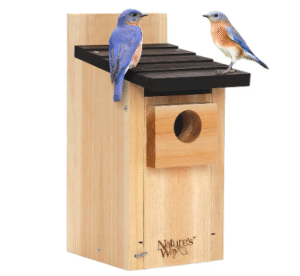The 7 Best Birdhouses: An Expert Review for the 2026 Nesting Season
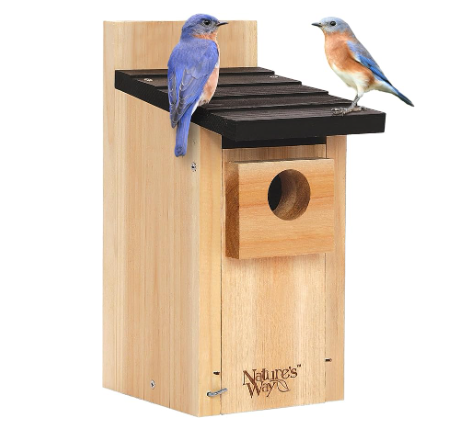
Early in my birding journey, I bought what I thought was a perfect birdhouse. It was brightly colored, had a cute little perch, and looked charming in my garden. It sat empty for three years. Frustrated, I started researching and realized my mistake: I had bought a “birdhouse-shaped object,” not a functional, safe home for birds. That decorative piece was, from a bird’s perspective, a death trap.
Since then, I’ve spent over a decade testing, mounting, and monitoring dozens of birdhouses in my Highland Springs, Virginia backyard. I’ve seen firsthand what works and what doesn’t. A great birdhouse isn’t about human aesthetics; it’s a carefully engineered piece of survival equipment. It must be safe, dry, temperature-regulated, and built to the exact specifications of the birds it aims to attract. This guide is the result of that extensive experience. We’re going to bypass the garden decorations and review the 7 best, most effective birdhouses on the market today, ensuring you can make a choice that leads to a thriving nest of fledglings next spring.
Our Top 7 Birdhouses at a Glance
| Model | Category | Best For | Price |
|---|---|---|---|
| 1. Nature’s Way Cedar Bluebird Box | Best Overall | Bluebirds, Tree Swallows | Check Price |
| 2. Woodlink Going Green Wren House | Most Durable | House Wrens, Chickadees | Check Price |
| 3. Coveside Convertible Roosting Box | Best Multi-Season | Small Songbirds (Year-Round) | Check Price |
| 4. Poly-Tuf Recycled Bluebird House | Best for Low Maintenance | Bluebirds | Check Price |
| 5. Nature’s Way Cedar Wren House | Best Compact Design | Wrens, Chickadees, Nuthatches | Check Price |
| 6. Audubon Cedar Chalet | Best Traditional Look | Mixed small songbirds | Check Price |
| 7. Woodlink Wood Duck Box | Best for Large Species | Wood Ducks, Kestrels, Owls | Check Price |
The Ultimate Birdhouse Buying Guide: What Our Experts Look For
The 7 Best Birdhouses: In-Depth Reviews for 2026
1. Nature’s Way Cedar Bluebird Box House
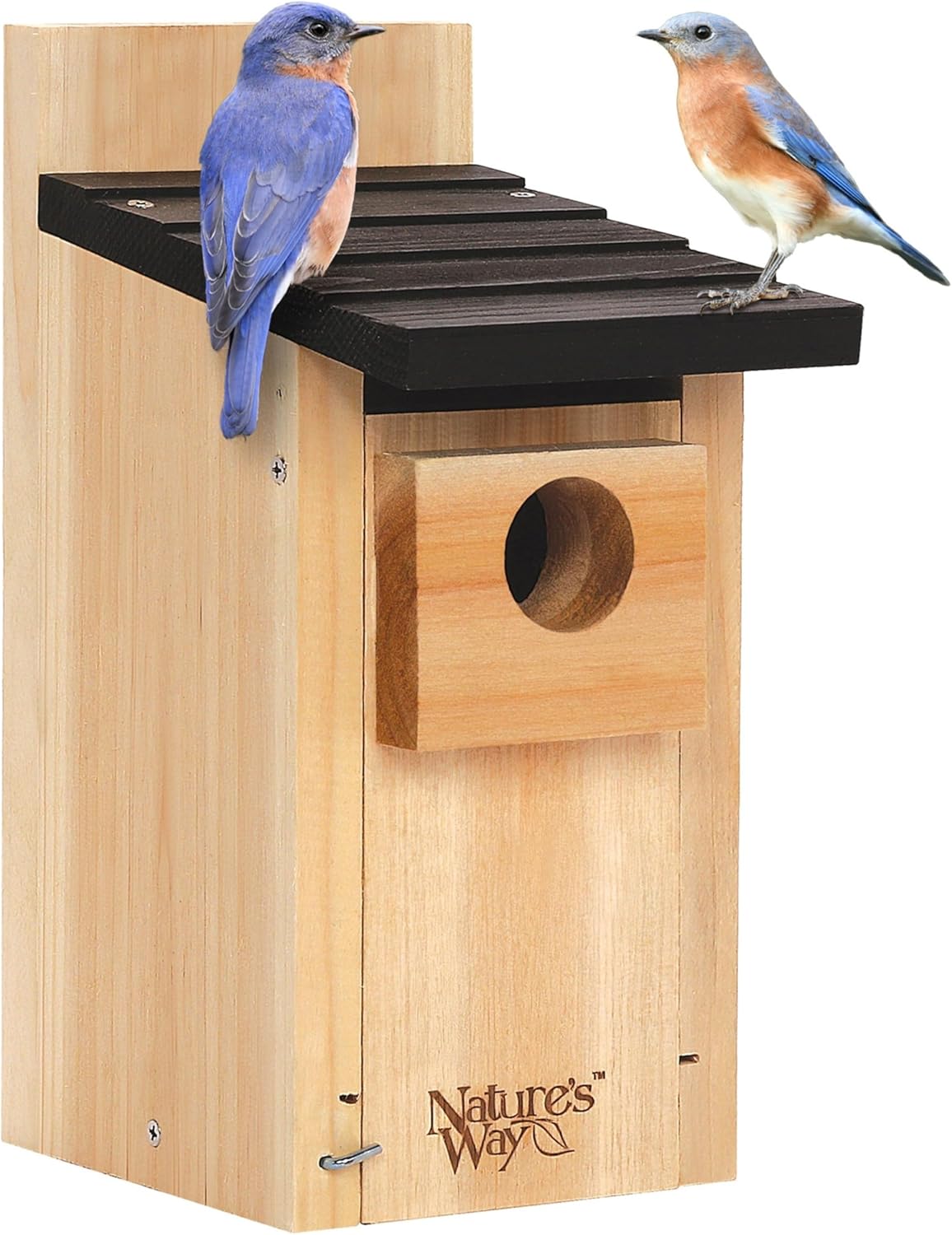
This Nature’s Way house is the gold standard and my top recommendation for anyone serious about attracting bluebirds. It hits every single mark for a safe, effective birdhouse. Constructed from thick, insect- and rot-resistant cedar, it’s built to last. The design is packed with clever, bird-friendly features: a 1.5-inch entry hole perfect for bluebirds, raised mesh flooring to keep nestlings dry, and ventilation gaps to prevent overheating. I particularly love the predator guard that extends the entrance hole, making it harder for raccoons to reach inside. The side panel opens with a simple pin for effortless cleaning. It’s a premium, thoughtfully engineered house that consistently gets results.
- Excellent Predator Guard: Built-in extended entry.
- Superior Drainage/Ventilation: Raised mesh floor is a game-changer.
- Durable Cedar Construction: Naturally weather-resistant.
- Easy to Clean and Monitor: Simple side-panel access.
- Higher Price Point: A premium product with a premium price.
- Specifically for Bluebirds: Hole size may be too large for smaller birds like wrens.
2. Woodlink Going Green Wren House

If you want a birdhouse that will likely outlast your garden fence, this is it. The Woodlink “Going Green” series is made from over 90% recycled plastic, creating an incredibly dense, tough material that will never rot, warp, crack, or fade. I’ve had one of these wren houses installed for eight years, and it looks exactly the same as the day I put it up. The 1-1/8 inch hole is ideal for wrens and chickadees while deterring most sparrows. It features a simple slide-up front panel for cleaning and adequate drainage. While it doesn’t have the rustic charm of cedar, its sheer longevity and zero-maintenance nature make it a fantastic and eco-friendly investment.
- Incredibly Durable: Will last for decades with no maintenance.
- Easy to Clean: Smooth interior surface is simple to wipe down.
- Eco-Friendly: Made from recycled plastic jugs.
- Correct Hole Size: Keeps larger birds out.
- Less Insulation than Wood: Can get hotter in direct sun, so placement in partial shade is key.
- Heavier than Cedar: Requires a sturdy mounting point.
3. Coveside Convertible Winter Roosting Box
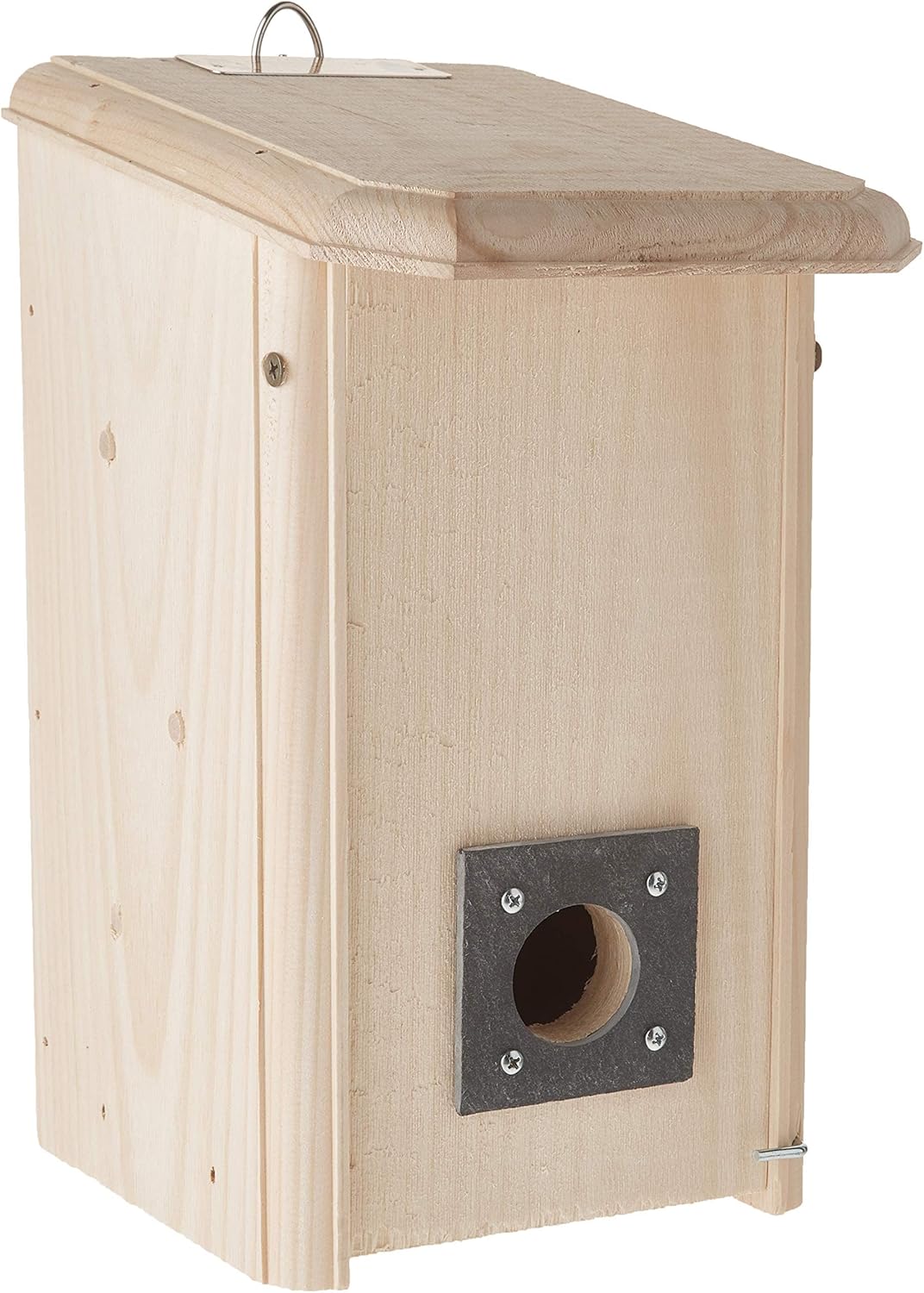
This is a brilliantly designed product for the truly dedicated backyard birder. In spring and summer, it functions as a standard, high-quality nest box for songbirds. But in the fall, you can flip the front panel upside down. This moves the entrance hole to the bottom and reveals three interior perches. Why? It turns the house into a winter roosting box! Hot air rises, so a bottom entrance traps warmth, and the perches allow multiple birds to huddle together for survival on freezing nights. It directly addresses the question of where birds sleep in winter by providing a dedicated shelter. Made in Maine from sustainable Eastern White Pine, it’s a product that shows a deep understanding of a bird’s year-round needs.
- Dual-Function Design: Nest box in summer, roosting box in winter.
- Supports Year-Round Survival: A truly valuable addition to a habitat.
- High-Quality Wood Construction: Built to last.
- Innovative and Educational: A great way to observe winter behavior.
- Requires Seasonal Conversion: You have to remember to flip the panel.
- Higher Cost: More expensive than a standard single-season box.
4. Poly-Tuf Recycled Bluebird House
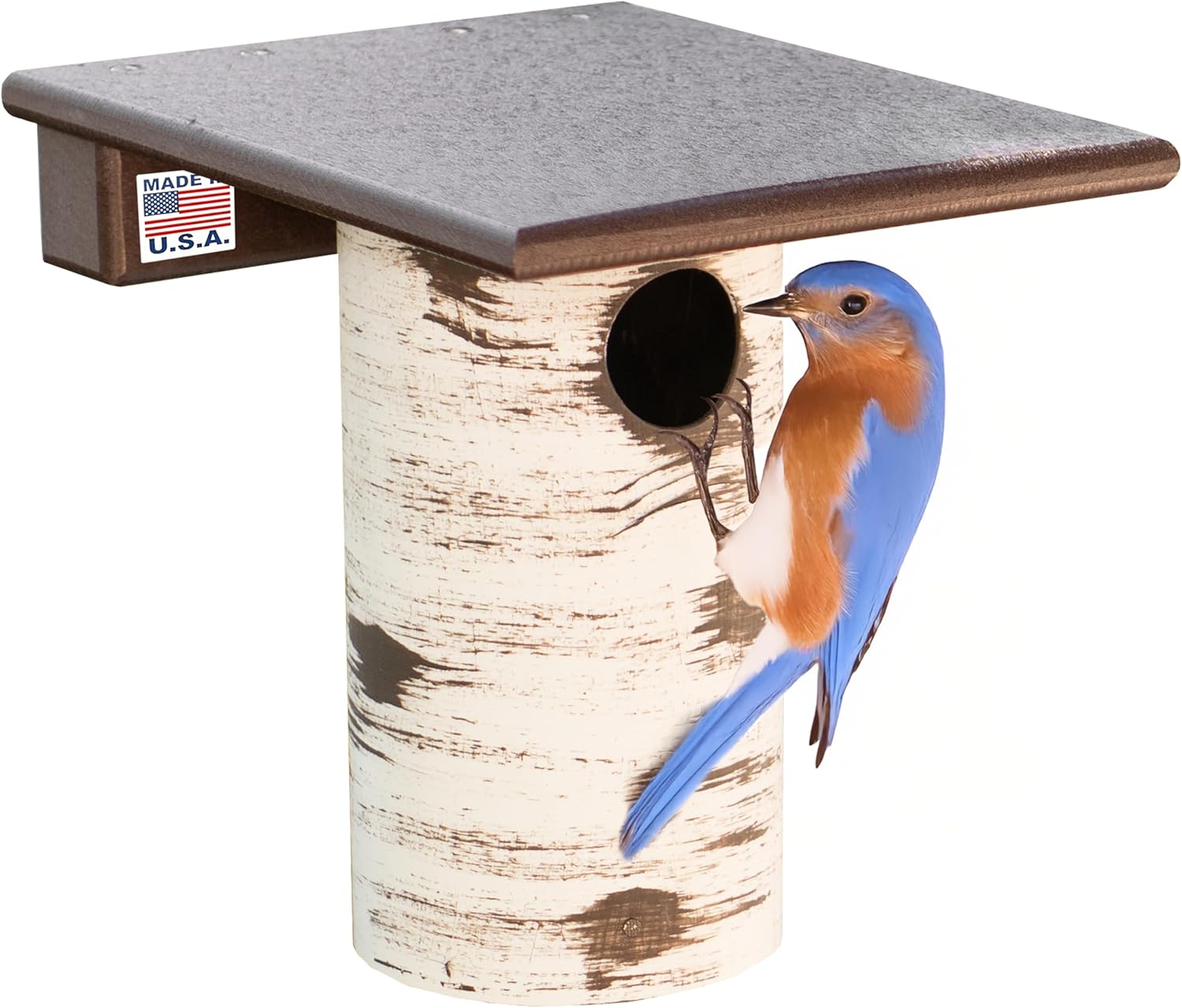
Similar to the Woodlink house but specifically designed for bluebirds, this Poly-Tuf house is for the “set it and forget it” enthusiast. It’s made from recycled poly-lumber, which feels and works like wood but has the durability of plastic. It will never need painting or weather-sealing. The design adheres to the recommendations of the North American Bluebird Society, featuring the correct 1.5-inch hole, excellent ventilation, and a side-opening door for easy cleaning. I’ve been particularly impressed with how well these hold up in the harsh summer sun and freezing winters here in Virginia. If you love bluebirds but want a house that requires absolutely minimal upkeep, this is an outstanding choice.
- Zero Maintenance: Material is weatherproof and fade-resistant.
- NABS Approved Design: Built to specifications that attract bluebirds.
- Easy to Clean: Side door provides full access.
- Stainless Steel Hardware: No rust.
- Heavy: Needs a very secure mounting pole.
- Higher Initial Cost: An investment that pays off in longevity.
5. Nature’s Way Cedar Wren House
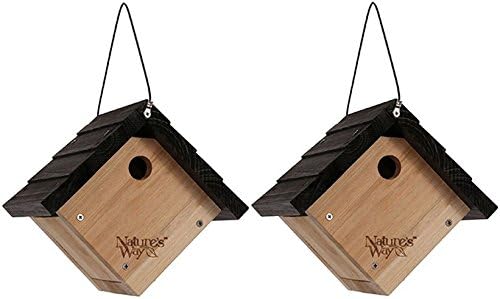
House Wrens are energetic, curious birds that aren’t shy about nesting close to human activity. This compact house from Nature’s Way is perfectly tailored to them. It’s smaller than a bluebird house, which wrens prefer, and features a 1-1/8 inch hole to keep larger birds out. Like its bigger bluebird cousin, this house is made from high-quality cedar and includes premium features like a stainless steel cable for hanging, a clean-out door, and drainage holes. Its small size and included hanging cable make it incredibly versatile—you can hang it from a bracket near a porch or a tree limb in the garden (provided it’s protected from climbing predators). It’s a charming, well-built, and highly effective little house.
- Perfect Size for Wrens: Compact and appealing to small birds.
- Premium Cedar Construction: Excellent quality for the price.
- Versatile Hanging Cable: Easy to place in various locations.
- Great Value: High-end features at an affordable price.
- Hanging can be less secure: Mounting on a pole is always safer from predators.
- Small size: Not suitable for larger birds like bluebirds.
6. Audubon Cedar Chalet Birdhouse

For those who want a functional birdhouse that also has a classic, rustic aesthetic, the Audubon Chalet is an excellent choice. Licensed by the National Audubon Society, this house adheres to proper ornithological design principles while maintaining a traditional look. It’s made from quality cedar, has a 1.25-inch entry hole suitable for a variety of small songbirds like chickadees and nuthatches, and features a side panel that opens for cleaning. It’s a simple, no-frills design that has been proven to work for decades. It’s a perfect starter house that looks great and, more importantly, provides a safe nesting cavity.
- Audubon Approved: Meets standards for bird safety.
- Classic Aesthetic: Looks beautiful in any garden.
- Versatile Hole Size: Can attract a variety of species.
- Affordable and Reliable: A great entry-level choice.
- No Advanced Features: Lacks predator guards or mesh floors of premium models.
- Softer Wood: Can be damaged by squirrels or woodpeckers over time.
7. Woodlink Wood Duck Box

Attracting larger cavity-nesters like Wood Ducks is a unique and rewarding challenge. It requires a much larger, specialized box, and this one from Woodlink is perfect. Made from durable cedar, it’s designed to be mounted on a pole or tree near a pond or wetland. The oval entrance hole is specifically shaped for Wood Ducks, and the interior has a built-in “ladder” of grooved wood to help the ducklings climb out when it’s time to fledge. The front panel swings open for easy clean-out. This box is also ideal for American Kestrels and small owls like Screech Owls. Remember to add a 3-4 inch layer of wood shavings inside for these species, as they don’t bring in their own nesting material.
- Designed for Large Birds: Perfect for Wood Ducks, kestrels, and owls.
- Includes Internal Ladder: Essential for ducklings to fledge.
- Durable Cedar Construction: Built to hold large birds and last for years.
- Easy to Maintain: Front panel opens for adding shavings and cleaning.
- Requires Specific Habitat: Only works if you live near water/wetlands.
- Heavy and Bulky: Requires a very strong mounting system.
How to Make Your Birdhouse a Home
Choosing a great house is step one. The next is convincing the birds to move in. Successful placement and habitat management are key. For a complete walkthrough, our definitive guide on how to get birds to nest in your birdhouse covers everything, but here are the essentials:
- Placement is Paramount: Mount your house on a pole with a predator baffle. Face it east, away from prevailing winds. Ensure it’s at the right height for the species you want to attract.
- Create a Good Neighborhood: Birds look for food, water, and cover. A nearby birdbath, feeders with the best bird seed, and native plants that provide insects and shelter will make your yard far more attractive.
If you’ve followed the rules and still have an empty house, our troubleshooting guide on how to get birds to use a birdhouse can help diagnose the problem.
Frequently Asked Questions (FAQ)
When is the best time to put up a new birdhouse?
The ideal time is in the fall or winter. This allows the house to weather and lose its “new” smell. Birds often scout for nesting locations well before the breeding season, which is governed by their internal clocks, so having it up early is a big advantage.
Should I put anything inside the birdhouse?
For most songbirds, no. Leave it empty, and they will bring their own materials. The major exception is for Wood Ducks, Kestrels, and Screech Owls, who require a 3-4 inch layer of wood shavings (not sawdust) at the bottom.
How far apart should I place multiple birdhouses?
For the same species (e.g., two bluebird houses), they must be at least 100 yards apart to respect their territory. For different species (e.g., a wren house and a chickadee house), you can place them much closer, perhaps 25-50 feet apart.
Conclusion: A Home for Generations to Come
Choosing a birdhouse is a small act of conservation with a big impact. By providing a safe, properly designed home, you’re helping to support your local bird population for years to come. Any of the houses on this list will serve you and your feathered tenants well. They are more than just garden decor; they are functional, life-saving structures that offer an unparalleled opportunity to connect with the natural world.
This guide reflects our top picks for the upcoming season. For our complete and continuously updated list, please visit the home of all our birdhouse reviews.
